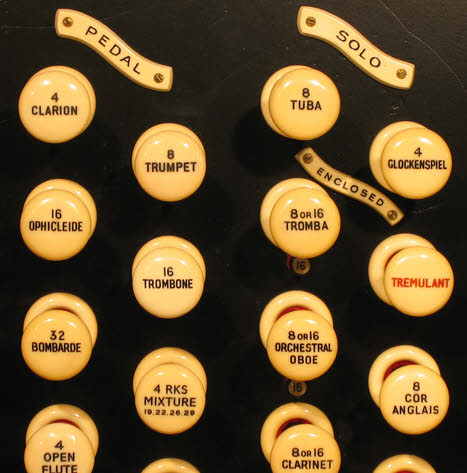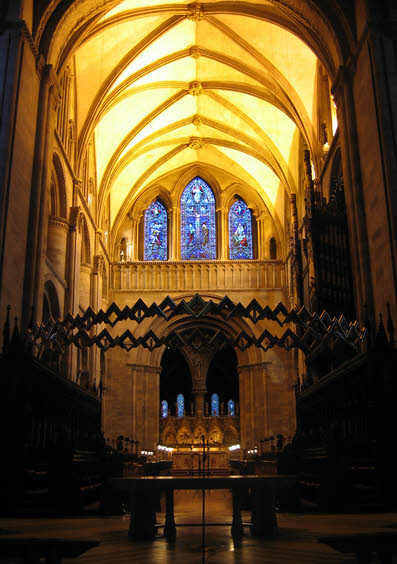

Hereford Cathedral
Hauptwerk (v5 and upwards) Virtual Organ
Hauptwerk (v5 and upwards) Virtual Organ
© Lavender Audio 2008 -

GREAT ORGAN
Based on Father Willis's full-toned and virile chorus work, this is a bold division with much variety. Harmonic development of the principal chorus is uniformly excellent and the Open Diapason 1 is a true English “Big Open”. The Great is unusual in that there are two Willis 16' flues and the Bourdon played up the octave makes for a very pleasant alternative Stopped Diapason. The Claribel Flute is the organ's big solo flute and is open all the way to bottom C. The 1978 quint mixture is designed to sit on top of the No.1 diapason and principal, where it adds considerable brightness. The original Willis tierce mixture along with the Twelfth and Fifteenth work with both No.1 and No.2 principals. Finally, the 16, 8, 4 reeds are vintage Willis and are an essential component of the tutti.
SWELL ORGAN
Save for the replacement of the Vox Humana with the 16' Dulzian, the Swell is exactly as built in 1892. Although steps have been taken to improve the egress of sound, it's tucked away high above the south aisle and, as a result, is considerably quieter than the Great. The Swell reeds are on heavy wind and therefore are the chief constituent of full Swell (interestingly, the tone of the Trumpet is somewhat rounder and more mellow in comparison with the brighter Double Trumpet and Clarion). The tierce mixture is a miniature version of that on the Great and , although smaller in scale, the Swell principal chorus is nonetheless quite bright. The Swell strings are mild and the Vox Angelica has dreamy remote feel ... indeed, the softest stops on the organ are found on this division.
CHOIR ORGAN
This division speaks out directly into the Quire and has the most direct and up front sounding ranks. As such, it is has the effect of an English positive or “chaire” organ and the 1978 addition of the sensibly pitched three rank mixture adds greatly to its flexibility. The Choir is useful as a mini Great, where the coupling of the Swell is very effective and the Choir can also be used as part of the build-up on the Great. With the Nazard and Tierce, a proper cornet separée is available and their addition to the Choir chorus makes for an interesting reedy sound. The Choir Trumpet has an interesting tone in the tenor register, which makes it a useful (fairly quiet) solo reed alternative. Finally the 8 and 4 foot Lieblich Flutes are fine examples of a stop that Henry Willis excelled in.
SOLO ORGAN
Another enclosed division that is mounted fairly high up, the Solo box shutters face east, thus limiting its effect in the Nave. The decision was taken to move the sampling microphones to get a more direct sound from what is a varied and interesting collection of stops. The Tromba, on heavy wind and located within the box, is a mini Tuba and is of similar power to the Great Trumpet. In contrast, the Tuba itself is far bigger in sound and is positioned over the Great to be heard to good effect further west. The French Cor Anglais is unusual in that it is a “free” reed – this means that the reed itself does not beat against a shallot, instead the method of sound generation is similar to that of a harmonium. The other two quiet reeds (Orchestral Oboe and Clarinet) are both conventional Willis ranks and, along with the Tromba, have 16 foot extensions. A family of harmonic and open flutes and two keen strings complete this division.
PEDAL ORGAN
Although one might yearn for a quiet 16 foot pedal Viola or Violone, the three existing pedal flues offer a good variety of weight, power and tone. The 32'/16' Open Wood and 32'/16' Bombarde/Ophicleide unit are the only unified ranks on the pedal. All other ranks are completely independent, with the exception of the Open Diapason which borrows its bottom octave from the Great Double Open. The 1978 additions allow this division proper independence from the Great, invaluable for the performance of polyphonic music.
THE ORGAN IN USE TODAY
This page gives a description of each division of the Hereford Cathedral organ. The effect of the instrument varies depending on the listener's position in the Cathedral, so what follows is very much from the perspective of the sampling position. Naturally, it is to some extent subjective, but hopefully gives a reasonably accurate picture of this marvellous instrument.







